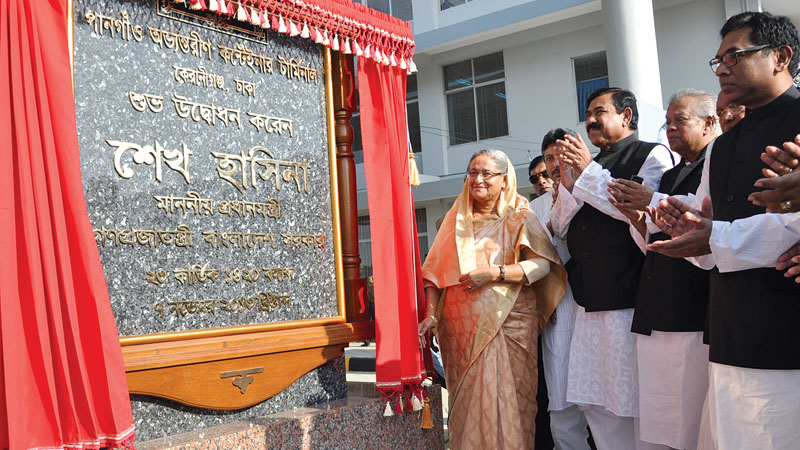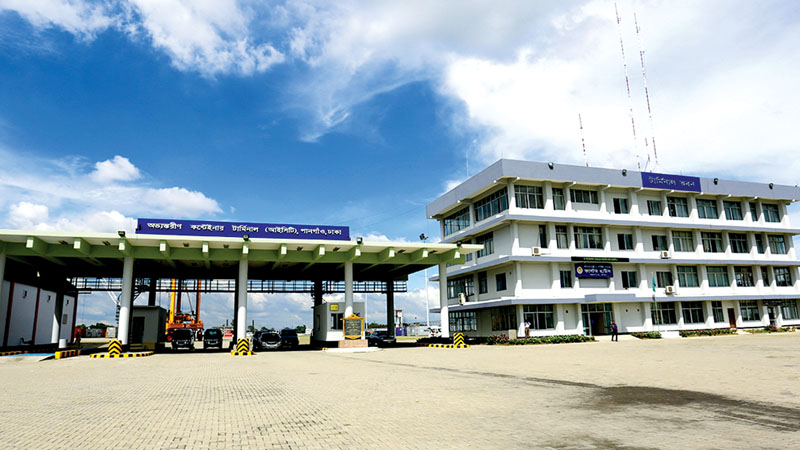Almost all trade routes lead to, and from, Chittagong Port in Bangladesh. So, for a far-sighted trader, what better way of transport could be there but the riverine way in a country that abundances in so many mighty rivers and canals connecting any two points on its land surface? Just for an instance, imagine 200 truckloads of container in a row cruising through the heavy traffic of Dhaka-Chittagong highway and then, think about the carbon emission and the noise pollution and the common risk of accident attached to it. While, it is comfortably possible carrying the same load of cargos onboard a single ship sailing through the rivers with greater ease, much less pollution and also within an agreeable amount of time!
CPA NEWS desk prepared the following report on the existing facilities as well as impending features of Pangaon Inland Container Terminal, PICT, the shadow-port close to the capital where dwells the trader’s peace of mind.
The beautiful country we call our home is the largest delta on the earth. Uncountable rivers and water bodies have embraced this land in many loops. These loops were the main connectors, which has brought people and businesses closer over the passage of time. In past, communication maintained mainly through the rivers and the mode was mostly sailboats. Merchants used to load their boats with goods and traded them off at different ports throughout the year. Commoners used boats to visit their kith and kin. Over the years, technology developed and transformed land transportation in manifolds. Water transportation, being a little archaic in its technology and time-consuming in its operation lost its leading role to its land and air counterparts. However, story does not stop there and time keeps changing. It brings in good omen for water transportation by the end of the day. Pangaon Inland Container Terminal heralds a new turn in that age old story.
Why Pangaon?
Globalization has made this country more connected with the outer world. Bangladeshi products are now exploring world market and goods from the outer world are finding their markets within the increased population here. Global goods mainly transported within containers, which require special arrangement and suitable place to be received and stored around a port facility. In Pangaon, these arrangements installed and prepared. The target of the terminal is to facilitate safe and easy transportation of containers carrying valuable goods to and from Chittagong and Mongla.
Chittagong port is the heart of Bangladeshi trade affairs, 92% of which are conducted through this. The country exports its products and imports its necessities via the terminals of this port. To expedite the transportation cost and find an alternative passage, Japanese donor agency JAICA piloted a survey on Dhaka-Chittagong waterway. The survey demonstrated the possibilities of inland water transportation supported by a widespread network of rivers and canals. Considering the feasibility of this study, the Government of Bangladesh decided to build an inland container terminal in Pangaon village near Keraniganj in Narayanganj.
The river Buriganga is 4 meter deep at Pangaon Terminal where small ships can easily anchor. Taking into account the navigability and communication ease found in the survey conducted by JICA in 1991, Pangaon Container Terminal began to take shape in 1993. For this purpose, 88 acres of land was acquired at that time. But shortly after, the construction stopped because of financial constraint. The construction work was restored in 2005 only when the Government took initiative for lessening the excess pressure from Dhaka-Chittagong highway.
The Birth of a Terminal
The building work was financed by Chittagong Port Authority (CPA) and scheduled to culminate in 2007. But it fell into systemic debacle again. In 2010 CPA invited Bangladesh Inland Water Transport Authority (BIWTA) to give them a hand in the construction of PICT. An agreement was signed accordingly between both parties and in June 2012 PICT finally came into being at a cost of BDT 158 crore. Eventually, a gross expenditure of BDT 300 crore plus 64-acres of land area helped shaping the Pangaon ICT. Of this, 35-acre covers the RCC yard, jetty and shade. The rest of the land was consumed for embankment and road construction. Prime Minister Sheikh Hasina officially inaugurated PICT on 7 November, 2013.
The Bright Sides
The 180-meter long and 26-meter wide Jetty at PICT can accommodate two ships at a time. The port and the terminal area totals 32 acres. The yard area is 55,000 square meter which can contain 2400 TEUs container. Container freight station area is 5815 square meter, where you can find 48 refer plugin points with stuffing and un-stuffing area of 13,969 square meter.
PICT is well equipped with all amenities of a modern container terminal. The modern machineries in PICT include one mobile harbor crane, 2 straddle carriers and 2 tractor trailers. To maintain 24 hours uninterrupted electricity supply at PICT, there are two generators each with a capacity of 1250 KVI/IMW. To prevent any sort of fire accidents two pumps along with fire hydrants remain at all times ready. PICT maintains an annual container handling capacity of 116,000 TEUs.
The waterway extends 157 nautical miles between Pangaon at Dhaka and Chittagong port. Except for Swandip, the average depth of this waterway is 4.5 meter. Though this depth is shallow near Swandip, container ships can pass this channel during tides ranging between 5 and 6 meters. This passage is currently being used to carry bulk cargos, petroleum and other goods. To facilitate the passage of container ships, the task of installing navigation helping machineries has been commissioned. Several Buoys and Mooring Buoys have also been purchased for this purpose.
PICT is being constructed with the aim to accelerate the container transport between Dhaka and Chittagong. 70% of the containers coming from abroad head for Dhaka and its surrounding areas. Pangaon terminal will make this process more cost effective, secure and eco-friendly compared to the road and rail alternatives.
Comfort Comes at a Cost
The goods carried by a small ship in its round trip from Dhaka to Chittagong and to Dhaka is equivalent to the goods carried by 400 general trucks in the same route by road. The calculation is true for 3 cargo trains if we consider the rail alternative. If a ship goes at a speed of 10 nautical miles an hour, it would take 16 hours to reach Pangaon form Chittagong. On the other hand, a truck covers the same distance within 5 to 7 hours.
Having said about the time related drawback with river transportation, we must consider the bright sides of this issue. Roadways are infested with robbery, burglary and in extreme cases, hijacking of the containers. In times of political unrest, roads and railways become more perilous for transportation. River based transportation can be an excellent alternative during those hard times.
Fuel Efficient, Environment Friendly
On a different note, river transportation is more fuel efficient and therefore, environment friendly. Uncontrolled carbon emission being the foremost reason of pollution, is the culprit behind the deterioration of earth’s precious ozone layer. Result, the intensification of UV rays on earth and global warming as its consequence. River transportation, carrying more cargos than its road colleague using lesser fuel, pollutes the environment at far minimal scale and can be called a greener alternative. Hence, Pangaon ICT opens the door to a more environmentally viable transportation solution in front of us.

Moreover, it will enhance the capacity of Chittagong port and cutback the average stay-period of containers in the port. As it is free from any sort of strike, blockade and unrest, Pangaon ICT will be able to deliver the cargos to the businessmen in due time.
Trans-shipment agreements have added more accolades to the achievements of Pangaon ICT. Bangladesh now can earn through charges from India or other neighbor states by means of these agreements, which allow them to transport their cargos using our port facilities. Even a few days back, Indian business people used to send their products first to Chittagong to get them to Dhaka or other destinations in country. But now, ships are directly coming to Pangaon ICT rather than via Chittagong, saving them huge time and big cost.
And There Is More
A connecting road of 5km length has been constructed to accelerate the passage of containers from PICT to Dhaka and other parts of the country. It is linked to the Dhaka bound highway, therefore to all corners of the country.
A branch of Sonali Bank operates within the PICT premises and efficiently manages the import-export activities. The bank is well employed with enough manpower and very soon going to install an ATM booth to further simplify transaction.
To smoothen the functions of Customs, a special system namely ASYCUDA WORLD SYSTEM has been installed at PICT. To prevent any sort of inconvenience, PICT authority has taken a zero tolerance policy in this regard. Importers and C&F agents can visit their goods before fixing the duties. PICT authority maintains robust security of the imported goods so that no Business entity has to suffer any loss.
Charge declined, Facilities enriched
To make the best use of opportunities at PICT, Chittagong Port Authority reformed the terminal charge structure in 2006. The charges were reduced by 30%-70% which would come into effect within the next 3 years. Besides cutting off the charges, new provision allows the ships to stay at the terminal for longer periods. As per the new rule, a container, with or without goods, can stay at the terminal for a maximum of 10 days without additional charge.
As a consequence of deducting the charges, a gross reduction of BDT 14,580 per container has occurred including the duties and transportation cost. The cost of transporting a 20-foot-long container by river route has come down to BDT 29,142 from BDT 44,436 in the past. The cost of transporting the same container by road stands at BDT 29, 452 and by rail at BDT 24, 851. Though, the rail option seems to be more lucrative here, actually it is not so due to its longer travel time.
The benefits of reforming the tariff structure is obvious these days. 2013, the first year of its operation marked the entry of only 8 ships at PICT. In 2016, this number jumped up to 76. Before deducting the tariff in 2016, the amount of total container handling was 4212 TEUs. In January 2017 alone, this amount has reached up to 1310 TEUs. In earlier days, PICT had received one ship in every 15 days whereas, it receives one ship in every 3 days now.

Future plans are at hand to make the operation of PICT smoother and faster. One of them is building of the elevated expressway project from Savar EPZ to PICT, which will mobilize goods between the two places without any obstructions.
Trader’s Peace of Mind
Considering the economic growth of Bangladesh, it is quite evident that, the country is stepping into the prestigious group of middle income countries very soon. Augmented business endeavors and extended import-export activities would exert tremendous pressure on the spinal cord of Bangladeshi economy, the Dhaka-Chittagong highway. To keep the wheel of economy rotating, two missions must be accomplished: one, relieving the Chittagong port of its surfeit pressure; two, finding an alternative way to connect the port with the capital.
PICT is one such attempt, which has been revitalized recently through the reformation of its tariff structure. PICT authority is determined to take it to the pinnacle of success where it will represent the economic transformation of Bangladesh.





